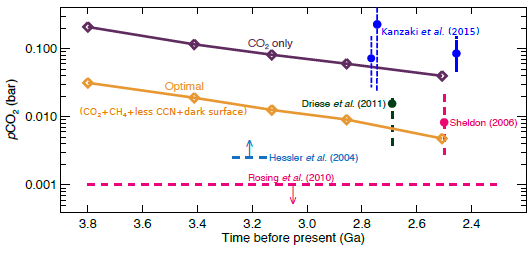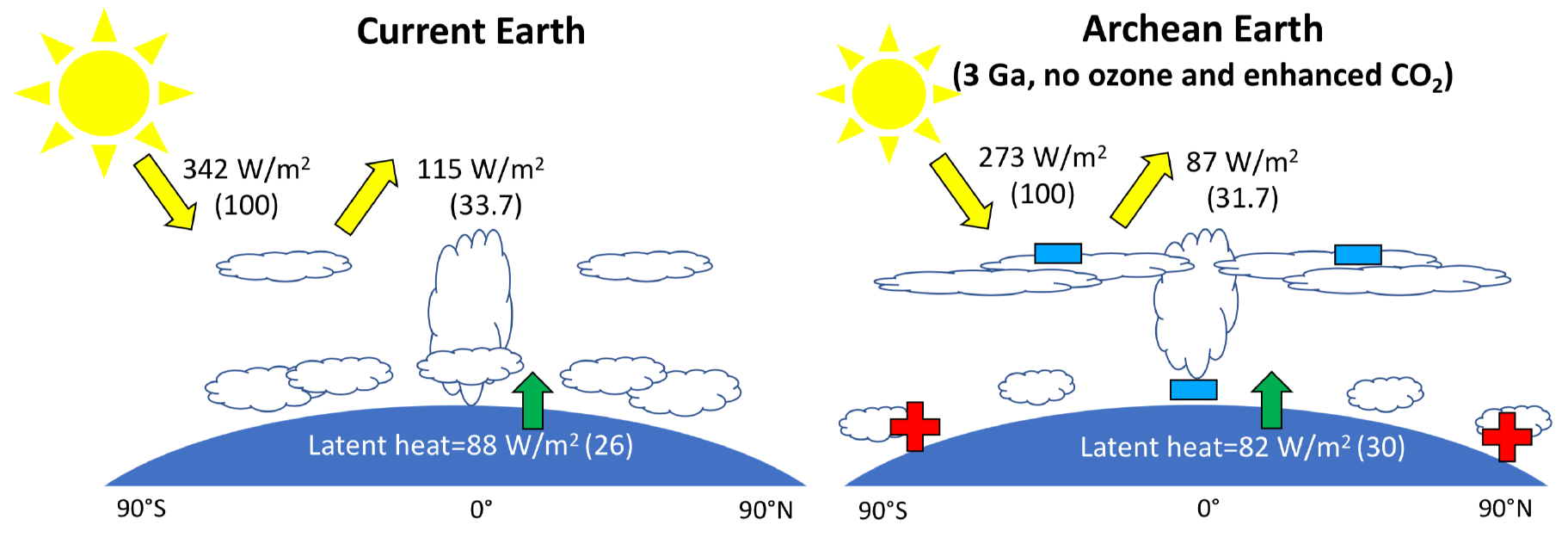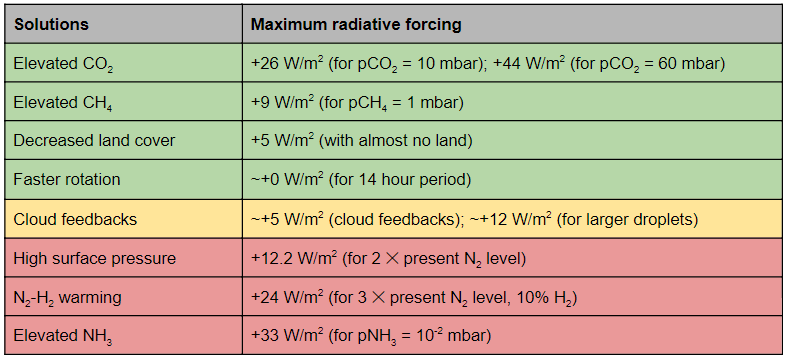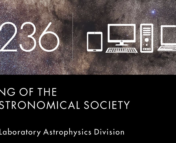Title: Is the faint young Sun problem for Earth solved?
Authors: Benjamin Charnay, Eric T. Wolf, Bernard Marty, and François Forget
First Author’s Institution: LESIA, Observatoire de Paris, Université PSL, CNRS, Sorbonne Université, Université de Paris, Meudon, France
Status: Accepted to Space Science Reviews, available as ArXiv preprint [open access]
Like other stars, our Sun has likely evolved and changed during its life—born of a molecular cloud, coalesced in a disk, and currently burning through its supply of hydrogen as a rather typical main sequence star. We infer this history by studying other stars at different stages of their life cycle and by creating models to help us simulate our own star’s evolution. An early realization of these studies was that the young Sun would have been 20–25% less luminous, resulting in a much colder Earth. However, our geologic record contradicts this lower solar luminosity with clear evidence that liquid water was abundant during the Archean (an early geologic eon stretching 3.8–2.5 billion years ago, AKA 3.8–2.5 Ga). This apparent discrepancy, known as the faint young Sun problem, has plagued researchers for decades. Greenhouse gases like carbon dioxide (CO2) could have kept the early Earth warm despite a less luminous Sun, but geochemical studies indicate there likely wasn’t enough present on early Earth. Today’s paper reviews the many possible solutions to this infamous problem and suggests that recent advances in modelling may be able to finally close the book on this so-called paradox.
The model of an increasingly luminous Sun as fusion leads to a denser, warmer core seems inscrutable. At the same time, ancient minerals on Earth indicate hydrothermal alteration by 4.2 Ga and geologic structures consistent with seafloor deposition by 3.8 Ga. Although the error bars on the constraints are sizable, relatively simple models indicate that greenhouse gases would need to be present in unreasonably large concentrations to allow for water oceans without help (see Figure 1). Thus, additional contributing factors have been considered, such as lower land surface area and differences in cloud coverage leading to decreased albedo (AKA reflectivity) and so greater absorption of heat. Today’s paper argues that improved three-dimensional models show such factors could work in combination with the greenhouse effect to keep the young Earth cozy.

Figure 1. Plot of the amount of CO2 needed to maintain a sufficiently warm Earth (288 K) over time during the Archean. The sloping purple line is a model for the CO2 needed if it is the only relevant factor and the orange line is the CO2 needed if various other factors are at play, including, 0.1 mbar of CH4, an 18 hour rotation rate, a dark soil surface, and reduced cloud droplet concentrations. The dashed lines give constraints on past CO2 levels argued by various authors. Figure 2 from today’s paper, originally adapted from Wolf and Toon (Astrobiology, 2014).
If your star’s too dim, change your planet!
To make the models work, various atmospheric compositions have been tried. Ammonia (NH3) was an early attempt at a solution, but it is destroyed too quickly to reach high enough concentrations. CO2 is generally the favored solution since it is released from the Earth’s interior and potentially well-regulated by the carbon-silicate cycle. However, since CO2 may not have been present at sufficiently high concentrations, methane (CH4) is also introduced into many models, sourced partly by geologic processes but overwhelmingly by methanogenic single-celled organisms. Increasing CH4 could raise the global mean temperature by 14 K, but the precise level is important because too much CH4 causes organic hazes that would decrease that effect. Nitrogen could help increase the effectiveness of other greenhouse gases and warm the atmosphere through increased pressure, but ultimately is not consistent with the geochemical constraints.
Other sources of warming in the models come from Earth’s changing albedo and rotation. An emerged land area of as little as 2 or 3% of the Earth’s surface during the Archean (compared to 27% today), predominantly composed of barren continents of dark basalt, would help lower Earth’s albedo. Perhaps the most important difference that can now be accounted for in the 3D models compared to previous 1D models is the feedback from cloud dynamics. Lower atmosphere clouds dominantly cool via increased albedo and upper atmosphere clouds dominantly warm via the greenhouse effect (see Figure 2). With a lower number of condensation nuclei for cloud droplets to form from the lower number of biological sources during the Archean, lower atmosphere clouds may have been thinner, and so had less of an albedo effect. The interactions between cloud cover, land area, and different types of radiation are complicated but ultimately allow for greater greenhouse warming under less outrageous CO2 levels than the earlier models necessitated.

Figure 2. Illustration of the possible cloud feedbacks for the present (left) vs Archean Earth (right) across latitude and atmospheric depth. Yellow arrows show global mean insolation and reflection, green arrows show heat flux from surface, red plus signs indicate warming of high latitudes, and blue minus signs indicate cooling of the equatorial region and upper atmosphere compared to present Earth. Overall, the early Earth may have had less low atmosphere clouds and more high atmosphere clouds. Figure 5 from today’s paper.
Complex interactions require complex models
Many models and methods of constraining early Earth’s conditions conflict in ways that can now be explained. Some have argued away the faint young Sun problem with findings that a fairly cold Earth could still have liquid water at the equator without going full snowball. However, these models likely oversimplify ocean dynamics, such as the important role of sea-ice transport. Other contributions, like a faster rotation rate (possibly with days as short as 10 hours) are likely to have been present, but with minimal effect on the global mean temperature. Some cooling in the Archean is expected from chemical weathering of impact ejecta in the ocean, such as that from the Late Heavy Bombardment, which would consume CO2. However, previous models have mostly neglected the relevant conditions of ocean chemistry and temperature that control this process. In addition, biology likely had a role in influencing Earth’s climate through both drastic cooling and warming, but is only now being accurately incorporated into models. Interestingly, the same advances that are solving climate questions about early Earth also help make predictions about the complicated interactions of many Earth systems that occur today under the force of anthropogenic climate change.

Figure 3. Table of proposed solutions to the faint young Sun problem with their expected contribution to warming. Green is for solutions that match available constraints, yellow is for solutions that only have theoretical constraints, and red is for solutions that don’t match available constraints. The lowercase “p” before a gas means “partial pressure” or the pressure that results from just the particles of that particular gas. Modified from Table 1 of today’s paper, with values sourced from numerous references therein.
A growing consensus can be seen that the Archean Earth was likely warm despite a cooler Sun thanks to elevated CO2 and CH4 levels, as well as the presence of less emerged land and more complicated cloud feedbacks than previously accounted for (see Figure 3). Of course, the faint young Sun poses similar problems elsewhere: ancient lakes and river valleys suggest a warm and wet surface on early Mars, even further from the young Sun’s warmth, highlighting that similar modelling feats are also necessary for understanding the climate evolution of our planetary neighbors. The authors of today’s paper conclude with the inspiring note that although the early Earth was rather different from our present world, it was habitable! The better we understand the early Earth the more we can understand about how life might arise on habitable exoplanets. Likewise, the more we learn about the evolution of young exoplanets the more we can say about our own world’s adolescence.




